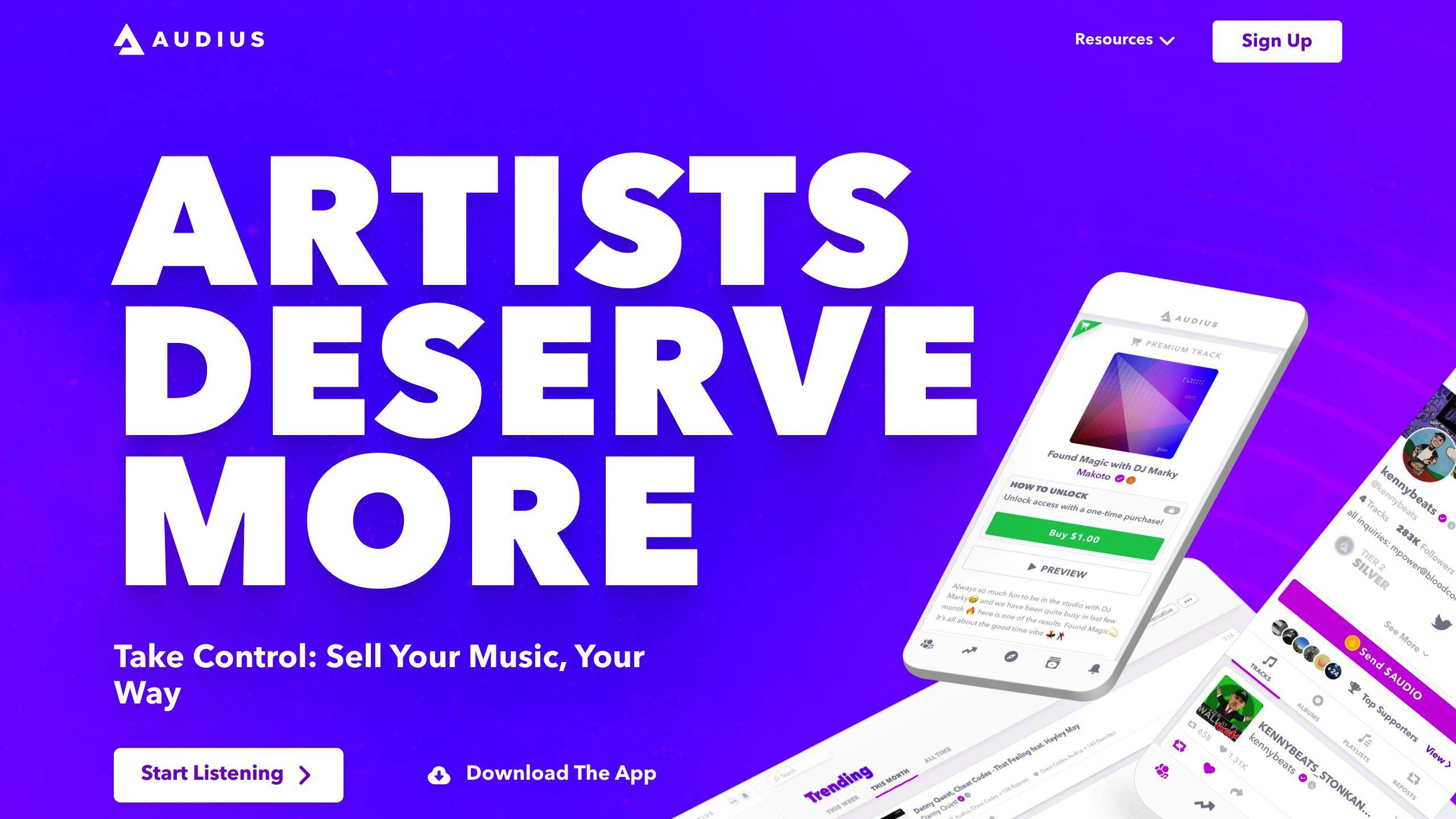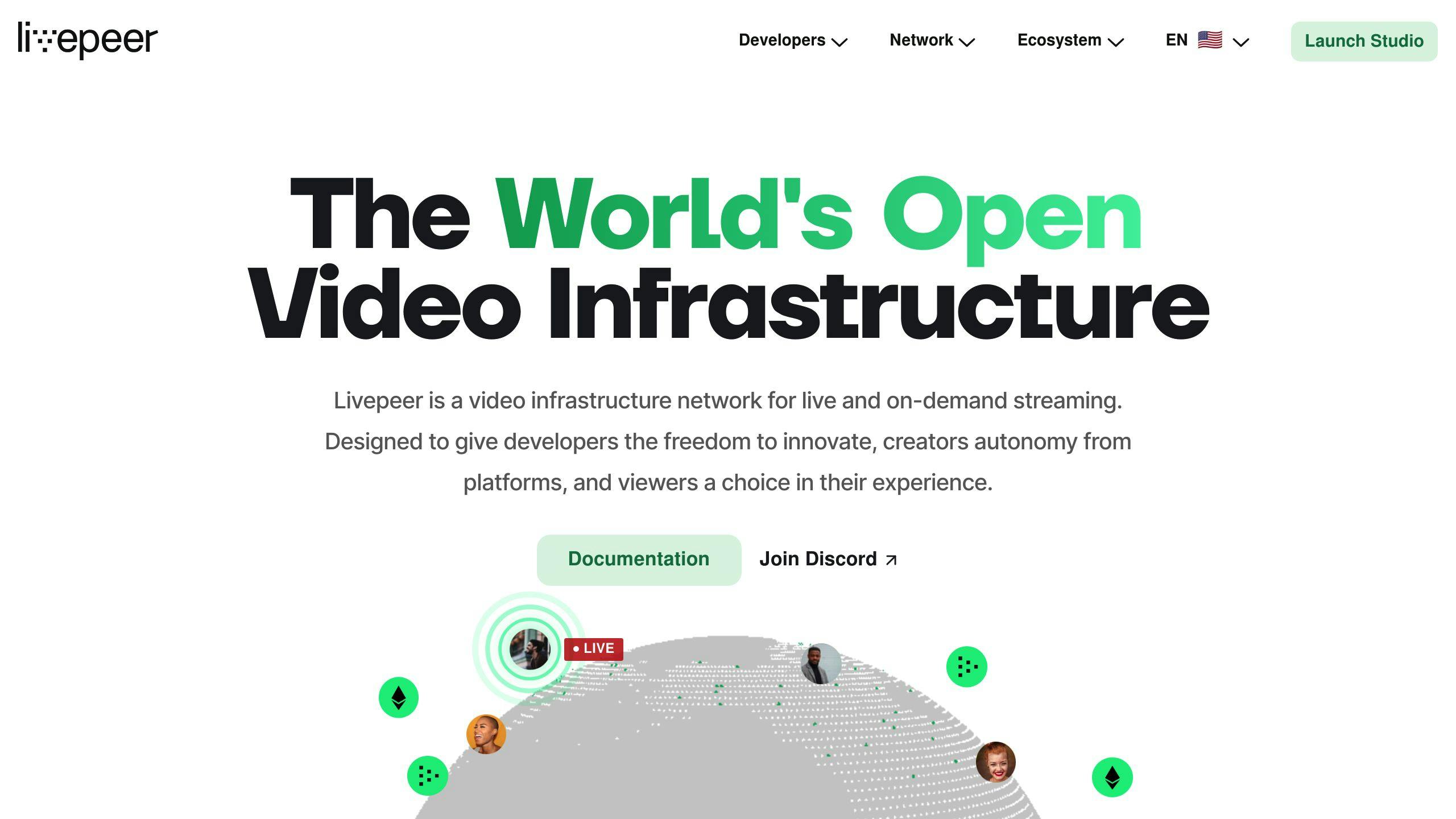Decentralized video sharing platforms are changing the game by allowing users to share and watch videos without the control of a single company. These platforms, such as Theta, Livepeer, and DTube, use blockchain technology to ensure transparency, security, and freedom from censorship. Here's what you need to know:
- Decentralized Storage: Videos are stored across multiple computers, making it difficult for content to be censored or taken down.
- Transparency and Control: Creators have clear insight into viewership and earnings, and full control over their content.
- Earn Rewards: Participants can earn digital tokens for hosting, sharing, or watching content.
- Community and Features: Choose a platform based on its community, features, and how it aligns with your content type.
Whether you're a creator looking for more control over your work or a viewer in search of unrestricted content, decentralized video platforms offer a compelling alternative to traditional, centralized sites like YouTube.
Benefits over Centralized Platforms like YouTube
When you compare these platforms to big names like YouTube, here's what you get:
- No one can just decide to take down your video because they don't like it.
- You can see exactly how many people watched your video and how you're earning from it, with no secrets.
- You're in charge of your videos and who gets to see them.
- It's a space where anyone can jump in and start creating or watching without waiting for approval.
- They introduce new ways for video makers to earn money that involve digital tokens, benefiting both creators and viewers.
For video makers who want more control and viewers looking for content that's not filtered or blocked, these decentralized platforms offer a fresh alternative to the usual, centralized video sites.
How Decentralized Video Sharing Works
Decentralized video platforms use a mix of new tech like blockchain, sharing systems where everyone helps out, and special setups to let people share videos without one big company in charge.
Requirements: Blockchain Base Layer & Peer-to-Peer Storage
- A blockchain base layer acts like a big, open book that keeps track of everything in a way that nobody can mess with it. It records important stuff like when a video is put up, how many people watch it, and how money is made.
- P2P protocols like IPFS, BitTorrent, or their own unique systems help share and store video files between people's computers, cutting out the need for big, central servers.
Infrastructure for Content Uploading and Streaming
There are special parts of the system that do certain jobs:
- Transcoding nodes change videos so they can work well on all kinds of devices and internet speeds.
- Relay nodes help pass videos from one person to another.
- API servers let apps and websites talk to the network.
- Encryption keeps videos safe from snooping eyes.
All these parts work together to let people put up and watch videos in a way that's not controlled by one big company.
Incentive Structures to Encourage Participation
The system uses digital money (tokens) to make sure everyone who helps out gets something back:
- Hosting videos or streaming them to others can earn you rewards.
- Watching or sharing content might get you rewards or make it cheaper for you.
- Securing the network by being a validator node comes with crypto rewards.
This setup makes sure the network can keep running on its own, without needing a central boss.
In short, decentralization takes away the middlemen with the help of a clear, open blockchain, sharing systems where everyone chips in, special tech setups, and rewards for those who contribute. This gives creators more control while making sure videos can still get to viewers efficiently.
Case Studies of Decentralized Video Platforms
This part of the guide looks at some big examples of decentralized video platforms like Theta, Audius, and Livepeer, and explains what they do in easy-to-understand terms.
Theta - Sharing Videos Without the Big Costs
Theta lets people help each other watch videos. Instead of one company sending you a video, other users help by passing bits of the video around.
- Users help by sharing parts of videos and get tokens called TFuel as a thank you.
- This sharing cuts down on the need for expensive setups usually needed to send videos across the internet.
- Big names like Samsung and Google Cloud are working with Theta.
Theta’s idea is to make sharing videos cheaper by having users help out, which also rewards them with cryptocurrency.
Audius - Music Sharing Made Fair

Audius is all about letting musicians share their music directly, without needing a big company in the middle to manage things.
- Musicians can put their music and cover art on IPFS, a way to store files that's hard to mess with.
- Deals on who gets paid and how much are handled automatically with smart contracts.
- Fans can show their support using AUDIO tokens.
- This system cuts out the need for record labels or streaming services that take a piece of the earnings.
Audius helps artists keep more of their earnings and connect with fans directly by using blockchain tech.
Livepeer - Making Live Video Easier and Cheaper

Livepeer is about making it easier and cheaper to send live videos by letting users help process the video streams.
- Anyone can set up a computer to help process video, earning LPT tokens as a reward.
- The system uses Proof-of-Stake, a method that helps keep things secure and fair.
- It's cheaper for people sending out live videos because they don’t have to pay big companies for processing.
- Watching and sharing videos can also earn you tokens.
Livepeer uses a community-driven approach to make live video streaming more affordable and open to everyone, rewarding users who contribute.
sbb-itb-bc761f5
How to Get Started with Decentralized Video
Choosing a Platform
When picking a platform for sharing your videos, think about a few things:
-
Community - Look for a place with active creators and viewers. This means more chances to work together and get your videos seen. Check out how lively their online groups are.
-
Features - See what each platform offers for uploading videos, how you can make your channel unique, ways to make money, and if it's easy to use on different devices. Pick one that fits what you want to do.
-
Incentives - Some platforms give you rewards like tips or payments for adding content. Think about if these rewards match what you're looking for.
-
Compatibility - Make sure the platform suits the kind of videos you make (like music, live streams, etc.) and works well with your other online profiles.
Checking out a few different platforms can help you find the right one.
Uploading and Sharing Videos
Here's how to start sharing your videos:
-
Create a channel - Make your profile and add your personal touch. You can usually make your channel look just how you want.
-
Upload videos - Follow the steps to add videos from your computer or another website. Remember to add titles, descriptions, and tags to help people find them.
-
Set visibility - Decide if you want everyone to see your videos, just certain people, or keep them private. Some platforms let you set different levels of access.
-
Share with your audience - Tell people about your videos through your website, emails, social media, and other ways to get more viewers.
Monetization Options
Here are some common ways to make money from your videos:
-
Tipping - Viewers can send you small amounts of money as a thank you.
-
Subscriptions - Fans pay a regular fee to get special content and early access.
-
Affiliate marketing - You can make money by promoting products or services you like.
-
Merchandise - Sell things like t-shirts, hats, or stickers with your brand on them.
-
Paid channel memberships - Offer extra perks for a monthly fee, like special mentions or getting to request content.
-
Limited editions - Sell unique videos or digital items for a higher price.
Try different ways to see what works best for you and your viewers.
Conclusion
Decentralized video platforms are changing the way we share and watch videos online, moving us away from the traditional, centralized systems. These platforms are built on blockchain and peer-to-peer technology, aiming to give creators more control, avoid censorship, and introduce new ways of earning through tokens.
Key Takeaways
- Decentralization means everyone can join in without needing permission from a big company. Platforms like Theta, Audius, and Livepeer use blockchain and file-sharing technologies to make sure videos can be shared freely. This means there's no single company in charge of everything.
- Creators get to call the shots. On these platforms, video makers can upload their work directly and see clearly how many people are watching and how much money they're making. They also get to decide who can see their videos.
- It's tough to block or remove videos. Because videos are stored in many places at once, it's hard for anyone to take them down or block them. If some parts of the network go down, there are always backups to keep things running.
- Tokens make the system work better for everyone. These platforms use digital money (tokens) to reward people for sharing videos, offering up storage space, or helping out in other ways. This can be a fairer and more open way to make money than traditional ads.
As we see more improvements in blockchain technology, decentralized platforms could become more popular for sharing videos, music, news, and more. For both creators and viewers, this new way of doing things offers more control, openness, and chances to create freely.
Related Questions
What is the best decentralized YouTube alternative?
DTube is often seen as a top choice for those looking for a YouTube-like experience but with a focus on keeping things private and decentralized. It uses the STEEM blockchain to store videos, which means they aren't easily taken down or controlled by one group. DTube looks a lot like YouTube but with the added perks of decentralization.
Is there a decentralized YouTube?
3Speak is a platform that lets people share videos without worrying about them being taken down for censorship reasons. It uses the STEEM blockchain to keep videos safe and available, offering a space similar to YouTube but without one company having all the control.
What does decentralized platform mean?
A decentralized platform is built on a network of many computers instead of just one main server owned by a single company. This setup prevents any one group from having too much power or control, making it a space where everyone can participate freely. Decentralized apps, or dApps, use this kind of network to run without needing a middleman.
Which platform is decentralized?
Ethereum is a well-known blockchain network that started in 2013. It's like the Bitcoin blockchain but also supports apps and services that run without being controlled by any single entity. This makes it a secure and fair place for cryptocurrencies, dApps, and other decentralized services to operate.



